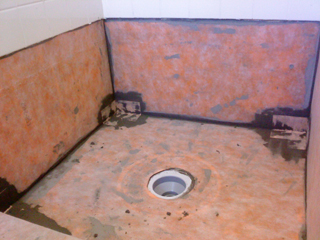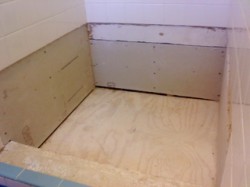 What the heck is Schluter Kerdi???
What the heck is Schluter Kerdi???
It’s a fairly new system for waterproofing showers that involves installing a membrane (the Kerdi) throughout the shower and over their special Kerdi drain. When finished you’ll have a completely waterproof, sealed shower. In fact, it’s so waterproof that you can install the Kerdi right over regular old drywall. That says a lot.
 Let’s look at how I installed the Schluter Kerdi shower system when I was repairing and old leaky shower pan liner that was decades old. In my last post (this link), I tore out the old tile down to the framing. Next, I replaced the subfloor with new plywood and added 1/2″ Hardibacker on the walls. (Yes, I could have used 1/2″ drywall, but I had the Hardibacker on hand…)
Let’s look at how I installed the Schluter Kerdi shower system when I was repairing and old leaky shower pan liner that was decades old. In my last post (this link), I tore out the old tile down to the framing. Next, I replaced the subfloor with new plywood and added 1/2″ Hardibacker on the walls. (Yes, I could have used 1/2″ drywall, but I had the Hardibacker on hand…)
INSTALL THE PRE-SLOPED SHOWER TRAY
The older method to doing a shower floor included making a sloped bed of mortar that would direct water toward the drain. This needed more time, labor and expertise. For this shower, I used a Schluter pre-sloped shower tray. It’s made out of some kind of foam and is easily cut to fit your particular shower.
After cutting the tray to size, I dry-laid it in place to mark the spot for the drain. Once the drain hole was cut out, I covered the floor with unmodified thinset mortar using a 3/16″ v-notch trowel. The shower tray sets in this. You can walk around on it to make sure it’s well embedded in the mortar. Just be careful not to crush it with your knees as you are working- it is foam after all.
INSTALL THE KERDI MEMBRANE
I’m not going to go through every detail of installing the membrane. If you are interested make sure to get the Schluter installation DVD and check out www.Schluter.com. The DVD comes with the shower kit and is great at showing every step along the way.
Basically, the membrane is installed over a thin layer of mortar and then flattened out and embedded using the straight edge of your trowel. The edges must all overlap by a minimum of 2″. I started by using something they call Kerdi-Band in all the bottom corners. (It’s just a thin pre-cut strip of the Kerdi material.)
 It helped to have two trowels or a putty knife so you can hold the membrane in the corner with one trowel while you smooth out the other side with the other one. It’s important to have tight square corners so that your tile will fit together correctly.
It helped to have two trowels or a putty knife so you can hold the membrane in the corner with one trowel while you smooth out the other side with the other one. It’s important to have tight square corners so that your tile will fit together correctly.
Once all the corners are done I installed larger pieces of Kerdi on the walls that overlap the corner pieces. Smooth them out to make sure there aren’t any air bubbles underneath. Schluter also makes special corner pieces that a pre-formed to fit into corners and over the curb corners.
INSTALL THE KERDI DRAIN
 The walls are done- let’s do the floor. I covered the floor with a layer of mortar and then pressed the Kerdi Drain into place. The flange has openings that will help it firmly integrate into the mortar. I spread a little more mortar around the flange and installed the Kerdi membrane, making sure to fully embed it, especially around the drain.
The walls are done- let’s do the floor. I covered the floor with a layer of mortar and then pressed the Kerdi Drain into place. The flange has openings that will help it firmly integrate into the mortar. I spread a little more mortar around the flange and installed the Kerdi membrane, making sure to fully embed it, especially around the drain.
That’s it! Let it set overnight and we’ll be ready to install the tile.











Pingback: Inspired Remodeling & Tile | Nashville, TN | Peter Bales, Contractor | Help! The Shower is Spraying on the Walls!